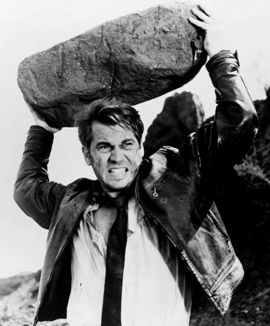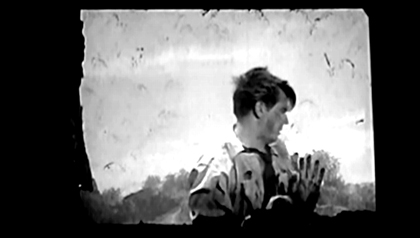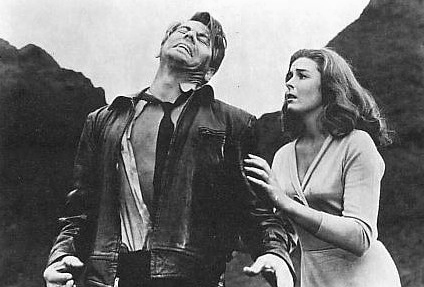
 |
|
|
|
I saw this unusual Columbia release a few weeks back in a good quality tape said to be made from a Sony Movie Channel cablecast ... a channel not accessible by me. Most Dangerous Man Alive (there's no "The") is indeed a minor release, just a notch or two above tepid Torch Lady offerings like Valley of the Dragons. But the 1961 film offers too much of tangential interest not to hold my interest. Besides, Debra Paget is in it. The only time I had laid eyes on it previously was a brief pass-by on a daytime TV channel around, maybe, 1968. In particular I remember a silhouette shot of Paget or co-leading lady Elaine Stewart in a sheer nightgown against a curtained window, which was a real sex education. You can bet I wanted to see the show again, just to find out if I had imagined the shot. Much later, film scholar James Ursini talked about director Alan Dwan's films with kindly respect, especially a late-career group of low-budget movies he made for producer Benedict Bogeaus back in the '50s. Most Dangerous Man Alive is the last of these, and Dwan's last credited picture. The movie is a fascinating mess that surely came about when a clever production scam blew up in the producer Bogeaus' face. The picture as finished has barely an ounce of style or creativity, yet it's fascinating -- it's like watching the skeleton of movie, that walks and talks even though there's no skin on the bones. We're told it was filmed in 1958, and spent three years on the shelf before being released. It isn't the kind of film that shows up in film festivals to be 'rediscovered'. 1 
The script is credited to ex-editor James Leicester, from a story by Australian actor Michael Pate and his brother-in-law, Philip Rock. Escaped hood Eddie Candell (Ron Randell of The Sign of the Ram, Kiss Me Kate and King of Kings) wanders into an atomic test site and is clobbered by a low-blast, high-yield Cobalt Bomb. Shocked that he's survived, Eddie discovers that his body now 'absorbs steel'. He's impervious to bullets and his skin texture is changing. Crime kingpin Damon (Anthony Caruso of The Asphalt Jungle) framed Eddie, with the help of Eddie's girlfriend, now Damon's moll, Linda (Debra Paget of Demetrius and the Gladiators, The Tiger of Eschnapur and The Haunted Palace). But Eddie easily kills Damon's hit men as he seeks his revenge. Linda is terrified, as is Eddie's other girlfriend Carla (Elaine Stewart of The Tattered Dress and The Rise and Fall of Legs Diamond), who believes in Eddie's innocence. She defies crooks and cops to help her lover escape. Another group of people is thrown into a panic. Atom scientist Dr. Meeker (Tudor Owen) explains to cops Davis and Fisher (Morris Ankrum & Gregg Palmer) that the bomb's purpose is to cause mutations. Eddie Candell needs to be located and 'neutralized' as soon as possible, before he absorbs too much steel and begins to give off high levels of radiation on his own. Back in the 1930s and '40s Universal gave us 'energized' madmen like Boris Karloff (The Invisible Ray) and Lon Chaney Jr. (Man Made Monster). They zapped people with cosmic energy and just plain old electricity, all for the sake of revenge. From the energy of Ron Randell's performance it would seem that Most Dangerous Man Alive wants to be the White Heat of this sci-fi sub-subgenre. Waxing hyperbolic and shouting his name as he attacks, Eddie Candell is definitely unbalanced. The acting in Most Dangerous is basically good, but the violent men and the attractive ladies are marooned in a plot that, with a little more practiced feeling of ennui, might be a good existential muddle for the likes of Michelangelo Antonioni. The movie is directed in a rush and is almost without visual distinction or attention to pacing. The police manhunt for Eddie Candell shows little in the way of urgency. Mobster Damon pulls off repetitious kidnaps -- Carla, Dr. Meeker -- in the hope of stopping the superhuman Eddie, who predictably walks through gunfire to break necks and toss bad guys from windows. Everybody knows that Eddie can't be reasoned with or intimidated, but they keep trying. Eddie Candell's atomic 'malady' never begins to make interior sense. Interestingly, the dialogue hints that Eddie's altered condition has done something to his libido, or his physical ability to make love. Both Linda and Carla look very disappointed, and wish that he would stop worrying and love the bomb, or vice-versa. Old flat 16mm prints of this show were almost unwatchable. Shots were not well lit, so that daytime rooms fell into darkness and faces in exteriors were often unreadable -- who's that in the car? Who are those people? Much of the audio is original location tracks of marginal quality, recorded in echoey rooms. The widescreen version from cable TV presents the show at optimum quality, only to show us how threadbare the film is. The film's interiors have a catch-as-catch can feel to them, with the gangster's headquarters looking like a restaurant filmed after business hours. The action is supposed to take place in Nevada and California, but the film was shot in Mexico. Little is done to hide the Mexican flavor of police uniforms, iron-gated haciendas and street signs. The few extras we see look, well, like they work in the Mexican film industry. 
The unimpressive bomb explosion is presented with Eddie pressing himself against a glass window, apparently in agony from that nasty, invisible nuclear exposure. The sequence is simply dull. By contrast, Bert I. Gordon's midnight bomb blast in The Amazing Colossal Man, with Glenn Manning flash-roasted before our eyes, looks like movie magic. A little bit later Dr. Meeker shows the police some mutated plants that look thrown together from papier-mache. Eddie's conversion to a Man of Steel is accomplished only with a few smudges on his cheeks, and perhaps a slightly darker makeup base. When Eddie 'absorbs' the chains on his wrists, we see a simple, unimpressive dissolve. There are no bravura scenes, no big-scale production values. A flamethrower squad finally corners Eddie in a featureless quarry. The most quotable moment in the film, noted in film books and even the original Variety review, has our furious ferrous fugitive suddenly revert to normal human flesh, just as the army's torches move in. We don't see anything happen, but Carla becomes excited when she notices that the police bullets are finally having some effect. She shouts in ecstatic relief: "Eddie! You're Bleeding!" What is going on? Why is Most Dangerous Man Alive such a fiasco? Allan Dwan had made several small-scale but rather sensitive and moving westerns for Benedict Bogeaus, like The Restless Breed with Anne Bancroft and The River's Edge, also with Debra Paget. At 72 years old, Dwan still handles his cast fairly well, but the camera blocking and lighting is terrible, as if something went seriously wrong with the production. Another Bogeaus movie from around the same time is From the Earth to the Moon, a color picture with big stars (Joseph Cotten, George Sanders, Debra Paget yet again) that saw release from Warner Bros. after RKO folded. The secret is that both Most Dangerous Man Alive and From the Earth to the Moon were filmed in Mexico at the Churubusco studios. Long rumored, and confirmed in Bill Warren's reference book Keep Watching the Skies is the fact that producer Bogeaus tried to game the system, and lost. Mexican film labor unions had a two-tier scale of fees, salaries and expensive extras. Feature film producers had to pay much, much more than people making TV shows. Bogeaus split his feature script into two TV scripts, brought down his cast and got ready to film. The authorities then determined that his show was really a feature - he was forced to hire a full Mexican crew at a higher pay scale. This broke the budget, forcing the filming to take place in a fraction of the time, foregoing elaborate special effects (or really, almost any special effects). The Mexicans were tired of cheapjack Yankee producers walking all over them, and decided to make an example of Bogeaus. Most Dangerous Man Alive certainly looks like it was filmed by a crew just going through the motions, doing every scene with a minimum of lighting and as few camera setups as possible. The word slapdash comes to mind. Just the same, the woe-begotten film holds a strange fascination. It's different than other no-budget sci-fi films of the 1950s, some charmingly incompetent (The Astounding She-Monster) and others that feel like an hour spent in purgatory (The Incredible Petrified World). Most Dangerous is a '50s pulp gangster and monster mishmash distilled to its raw ingredients -- guys with guns, grimacing monster-hero, a shivering sexy love interest. It's like a stage play without costumes or sets, with the actors trying in vain to compensate. When film critics began doing genre studies in the late 1960s, "auteur"-inflected pieces tried to tie this science fiction film in with Alan Dwan's reputation as an industry great who was one of the first directors ever to work in Hollywood. Occasional old retrospective notices will see great drama in the tragedy of Eddie Candell and his loyal Carla, as if the film's inanities were an artistic choice on the part of director Dwan. Genre-based criticism of the time tried and failed to elevate the artistic merit of directors like Jack Arnold. 
Most Dangerous is possibly just a production fiasco, an independent picture that might have had possibilities but ran into hard luck. Who knows, Dwan and a designer might have had something visually interesting in mind before things went wrong. Plenty of independents fall victim to the necessity of Just Getting It Done and Moving On. In 1983 Wim Wenders made an entire feature in Lisbon, about a film company stranded while filming a low-budget science fiction movie called "The Survivors". Most Dangerous is often identified as the model for this movie-in-a-movie, but so is Roger Corman's The Day the World Ended. Bill Warren says that the scenes being filmed in The State of Things actually look more like imitations of Joseph Losey's These Are the Damned. Today movies with stories like Most Dangerous Man Alive become overblown $30 million dollar comic book epics. Dwan's last film comes across as an unconscious 'outline' for a pulp sci-fi saga, minus all the things we take for granted -- opulent production values, impressive visual effects, overstated, graphic novel - influenced dynamism and blocking. Filmed on autopilot, Dwan's film looks like an 'accidental' genre deconstruction. As a purposeful genre deconstruction I offer Jean-Luc Godard's Alphaville. Godard strips away the Hollywood trimmings from a Superspy/Sci-fi adventure story, replacing a futuristic city with normal modern architecture. But as the antidote for all the computer-cold futuristic glitz, he proposes humanistic poetry. Godard's film is a sketchbook masterpiece, but who says that 'poetry' has to be intentional, or involve words? The botched rush-job Most Dangerous is a hard-luck ode to the risks of low-budget independent filmmaking. Columbia-Sony's Most Dangerous Man Alive doesn't appear to have been released on Sony's MOD film program. The copy I saw on videotape looked quite good, even with its cheap titles. One odd thing that occurs right at the front of the film immediately knocks it into quasi-ludicrous territory. Gangster Damon looks at a magazine revealing Eddie Candell's high-profile lifestyle, and we see photos of Eddie in various locations, including sitting at a bar with Linda. Only a few minutes later, a matching scene comes up. Stills from the film shoot were used to produce the fake magazine layout, giving the impression that the magazine has somehow published photos taken in the future.
On a scale of Excellent, Good, Fair, and Poor,
Most Dangerous Man Alive rates:
Footnotes: 1. A welcome note from author Tom Weaver, 2.14.13: Great article!
FYI, according to Dwan, he too was kept in the dark by Bogeaus about what Most Dangerous Man Alive really was; in an interview, he said he was under the impression it would be a two-part TV pilot. Once the Mexicans saw through Bogeaus' scheme, the budget tripled and, says Dwan, "What should have been done in five weeks was done in one." (I'm sure Dwan is exaggerating; the actors I've interviewed said it took longer than a week.) The claim that it was shot in 1958 ... untrue. It was shot in April-May 1960. And I also recently read that the reason for the (slight) delay between production and release was the Screen Actors Guild, who'd been made aware that some of the actors hadn't been paid for overtime and for clothes damaged during production.
Reviews on the Savant main site have additional credits information and are often updated and annotated with footnotes, reader input and graphics.
Review Staff | About DVD Talk | Newsletter Subscribe | Join DVD Talk Forum |
| ||||||||||||||||||